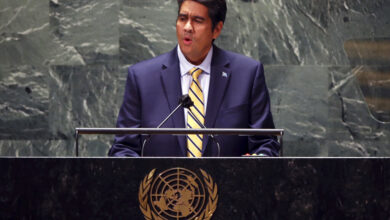PRC dams contributing to worst drought in Southeast Asia’s Mekong region in more than a century

FORUM Staff
Extensive drought in the Mekong River region of Southeast Asia is renewing concerns about the People’s Republic of China’s (PRC’s) construction and management of upstream dams.
In July 2019, water levels were lower in the Mekong basin than in 2016, which at the time was considered the worst drought in the region in a century. (Pictured: A motorcycle rider passes a dried cornfield in Chai Nat province, Thailand, in March 2016. The 2019 drought conditions throughout much of Southeast Asia are more severe.)
A series of dams in China have blocked a combined total of over 40 billion cubic meters of water, according to a study by a civic group known as Mekong Butterfly, reported Thai PBS World, the English news website of the Thai Public Broadcasting Service. PRC dams are the main cause of unnatural flows of the Mekong River, which flows from China through Burma and Laos into Thailand, Cambodia and Vietnam, the study found.
Various weather phenomena such as El Nino contributed to a strengthened dry season this year, experts said. The monsoon rains were delayed for several months, worsening drought conditions.
The lowest water level in Thailand was observed in mid-July 2019 when the Jinghong dam, the most downstream dam in China’s Yunnan province, cut the water flow rate through the dam to 500 cubic meters per second.
“What has happened in the last few weeks is that the Jinghong dam has not released water or has released less water than it normally does during the monsoon season. And this is likely because the needs of that dam are prioritized over the needs of everyone downstream,” Brian Eyler, the Southeast Asia program director for the Stimson Center, told Radio Free Asia’s (RFA’s) Vietnam Service in late July.
On July 18, China increased the flow to 1,000 cubic meters per second. The Jinghong dam is one of 11 dams to be completed on the PRC-controlled section of the upper Mekong.
The increase, however, provided little relief for several northern and northeastern provinces of Thailand, according to Mekong Butterfly and the Mekong Freedom Network.
Drought is also severe in Laos. “In the last few years, at least the last five years, drought conditions are getting worse. It rains less in the North. They, the locals, say the problem in the lower Mekong region is the dams because the dams make the droughts worse,” Premrudee Daoruang, coordinator of the Laos Dam Investment Monitor, an environmental group, told RFA’s Lao Service. “China is also experiencing a drought, so [they] close and open [their] dams, causing changes downstream.”
In addition to the large Chinese dams, there are dams in Laos that could be holding back water, Eyler and Daoruang explained, such as the Xayaburi dam in northern Laos, which has been testing operations. There are 60 other dams in Laos, which are much smaller, on tributaries to the Mekong and another 60 under construction.
The problem is exacerbated as the river flows farther downstream. “Communities, particularly communities that live alongside the Mekong downstream in Thailand, Laos, Cambodia and Vietnam are those that are being affected the most,” Eyler told RFA.
The Thai government asked the PRC, Laos and Burma to release water in late July, and Thai Prime Minister Prayut Chan-o-cha said the countries are cooperating, according to The Bangkok Postnewspaper.
Long-term water management problems loom ahead. “There are plans for 500 dams that could be built. Five-hundred! It’s an incredible number of dams being built in the Mekong basin. No one knows what their impacts will be, and that’s a very scary proposition,” Eyler told RFA.
The way the flow is managed is also problematic. The start and stop of the flow can damage crops, animals and equipment and cause loss of biodiversity. Formal mechanisms for sharing water in the Mekong region among nations are not yet in place.
Farming communities are among the hardest hit by drought. More than 61% of the population in Laos, 41% in Vietnam and 27% in Cambodia derive their livelihoods from agriculture, according to In Depth News, an agency of the International Press Syndicate.
Gen. Prayut expressed concern about farmers’ livelihoods, given only 40% of Thailand’s farmland is irrigated.
“I am worried about farmers because they have invested much, but there is a water shortage. Irrigation must be limited to maintain tap water production and protect consumers. The government will offer assistance to relieve the damage,” The Bangkok Postreported.
In addition to hitting the poor the hardest, the cumulative effect of drought in the region heightens inequality, degrades land and increases the potential for violent conflict, In Depth News reported. Droughts also cause human health problems by limiting access to safe water and increasing risk of forest and range fires.
For details on the Mekong Butterfly study, see Thai PBS World:
For more information on dams in Laos from Radio Free Asia, see:
https://www.rfa.org/english/news/special/china-build-laos-dams/




